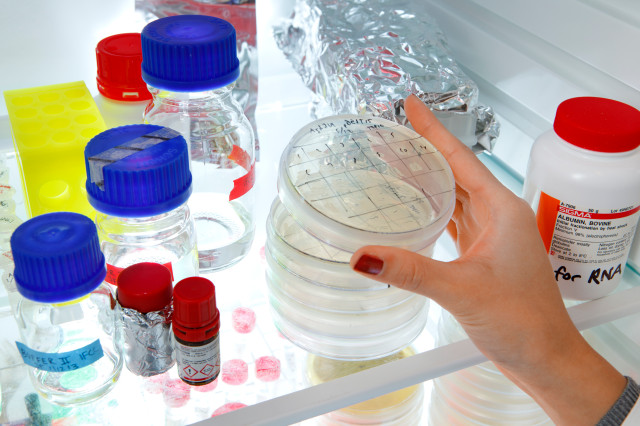BB1030 Microbiology 9.0 credits

The course handles micro-organism morphology and structure along with their occurrence in nature. Taxonomical and physiological aspects of viruses, bacteria, protozoon, algae and fungi are covered. Special consideration is given to the bacteria cell, its nourishment demands and growth. Control of growth is clarified through sterilization, disinfection and antibiotics. The basics of bacterial genetics are covered along with bacterial genetic development toward modern phylogenetics with the help of gene sequencing of 16s rRNA. Mechanisms for sickness, for example: toxins and bacteria which are resistant against the body’s defenses, are also covered. Some meaningful microbial sicknesses are given as examples. Significant microbial processes for application within traditional and modern biotechnology are also covered. A couple of examples of such processes are biological water purification and ground-decontamination.
Choose semester and course offering
Choose semester and course offering to see current information and more about the course, such as course syllabus, study period, and application information.
Application
For course offering
Spring 2025 Start 14 Jan 2025 programme students
Application code
60637
Content and learning outcomes
Course disposition
Lectures
The course consists of 16 lectures with specified learning outcomes.
Labs
The course begins with light and phase contrast microscopy, general sterilization techniques and measurements of bacterial concentration. Next comes a connected, coherent lab which consists of planning and execution: isolation, clean cultivation, and characterization of bacteria from a natural environment with the help of microscopy, cultivation on selective and differentiated mediums, proof by enzymes and other microbial products along with antibiotic spectrum. Also, in this lab, nourishment mediums and substrates are to be prepared to cultivate aerobically and anaerobically as well as searching for information about isolated bacteria being cultivated. The results are presented in a seminar orally,
in a written report, and as a poster. A modern technique to color bacteria’s ribosome with the help of fluorescent-labeled probes is taught. This technique, FISH, is used to see specific bacteria in their natural environment. With this, 16s rRNA is isolated and sequenced for further work with the bioinformatics course.
Practice assignments
During the exercises, the students work with questions where the serach information online, in scientific literature and in the course literature.
Group exercise
Students will work in groups to write an in-depth work around a topic where microorganisms play a fundamental role in creating a sustainable society.
Course contents
The course handles microorganism morphology and structure along with their occurrence in nature. Taxonomical and physiological aspects of viruses, bacteria, protozoa, algae and fungi are covered. Special consideration is given to the bacterial cell, its nourishment demands and growth. Control of growth is clarified through sterilization, disinfection and antibiotics. The basics of bacterial genetics are covered along with bacterial genetic development toward modern phylogenetics with the help of gene sequencing of 16s rRNA. Mechanisms for sickness, for example: toxins and bacteria which are resistant against the body’s defenses, are also covered. Some meaningful microbial diseases are given as examples.
Significant microbial processes for application within traditional and modern biotechnology are also covered. A couple of examples of such processes are biological water purification and ground decontamination.
Intended learning outcomes
After passing the course, the student should:
- have a general knowledge about microorganisms and their occurrence in nature
- understand structure, replication and physiology of microorganisms
- be aware of techniques for identification of microorganisms
- have an awareness of microorganism cooperation with and ability to harm other living organisms
- Choose and select suitable methods to control microbial growth
- understand implications of microorganisms for science and industry, specifically on the environment, human beings and the society
- describe societal factors that are responsible for the spread of antimicrobial resistance
- master presentation techniques to be able convey scientific observations
Literature and preparations
Specific prerequisites
Completed upper secondary education including documented proficiency in English corresponding to English A.
Recommended prerequisites
BB1010 An Introduction to Biochemistry and BB1020 Cellbiology with immunology.
Equipment
Literature
Brock Biology of Microorganisms, 16th edition, 2021. M. Madigan, J. Martinko, K. Bernder, D. Buckley, and D. Stahl.
Examination and completion
If the course is discontinued, students may request to be examined during the following two academic years.
Grading scale
Examination
- LABA - Laboratory Work, 3.0 credits, grading scale: P, F
- PROA - Advanced study, 0.5 credits, grading scale: P, F
- TENB - Written exam, 5.5 credits, grading scale: A, B, C, D, E, FX, F
Based on recommendation from KTH’s coordinator for disabilities, the examiner will decide how to adapt an examination for students with documented disability.
The examiner may apply another examination format when re-examining individual students.
Other requirements for final grade
Passed examination (TENA; 5,5 credits, grading scale A-F), passed laboratory exercises (LABA; 3 credits, grading scale Pass/Fail) and passed group exercise (PROA; 0.5 credits, grading scale Pass/Fail)
Opportunity to complete the requirements via supplementary examination
Opportunity to raise an approved grade via renewed examination
Examiner
Ethical approach
- All members of a group are responsible for the group's work.
- In any assessment, every student shall honestly disclose any help received and sources used.
- In an oral assessment, every student shall be able to present and answer questions about the entire assignment and solution.
Further information
Course room in Canvas
Offered by
Main field of study
Education cycle
Add-on studies
Supplementary information
Students are required to sign up at least two weeks in advance for examination.
The course is given provided at least seven students are admitted.